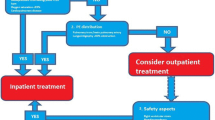Abstract
We analysed time trends in the pulmonary embolism (PE) mortality rates in Germany from 2004 and assessed for an association between the use of anticoagulants and PE caused mortality. We extracted age-specific number of deaths due to PE (ICD-10 I26) from 2004 to 2011 as available from the WHO mortality databases. In addition we derived defined daily dosage (DDD) of prescribed anticoagulants and the low molecular heparin Enoxaparin for the years 2004–2011 from the statutory health insurance-drug-information system reports. Age-standardized PE mortality per 100,000 decreased from 5.9283 in year 2004 to 4.4876 in 2011 (−24.3 %). Amounts of prescribed anticoagulants increased in this period from 271,810.7 × 1000 DDD to 416,611.8 × 1000 DDD (+53.3 %), that of Enoxaparin increased from 27,071.1 × 1000 DDD in 2004 97,276.5 × 1000 DDD in 2011. The PE mortality is negatively correlated with anticoagulants (−0.9463, p = 0.0004) as well as with enoxaparin (−0.9740, p < 0.0001) and of DDD of Enoxaparin per 1000 insured (−0.9682, p < 0.0001). In univariate linear regression model, anticoagulants, Enoxaparin and Enoxaparin per 1000 insured all reach significance (p = 0.0004, p = 4.31 × 10−5 and p = 0.0001 respectively). Multiple regression models show that Enoxaparin has the most robust effect. Including the time trend in the model does not alter the results. Our study shows that increasing number of prescribed Enoxaparin in an outpatient setting might be one determinant of decreasing PE mortality rate in Germany since 2004.



Similar content being viewed by others
References
Geerts WH, Bergqvist D, Pineo GF, Heit JA, Samama CM, Lassen MR, Colwell CW (2008) Prevention of venous thromboembolism: American College of chest physicians evidence-based clinical practice guidelines (8th edn). Chest 2008: 381S–453S. doi:10.1378/chest.08-0656
Kahn SR, Lim W, Dunn AS, Cushman M, Dentali F, Akl EA, Cook DJ, Balekian AA, Klein RC, Le H, Schulman S, Murad MH (2012) Prevention of VTE in nonsurgical patients prevention of VTE in nonsurgical patients: antithrombotic therapy and prevention of thrombosis, 9th ed: American College of chest physicians evidence-based clinical practice guidelines. Chest 141(2_suppl):e195S–e226S. doi:10.1378/chest.11-2296
Gould MK, Garcia DA, Wren SM, Karanicolas PJ, Arcelus JI, Heit JA, Samama CM (2012) Prevention of VTE in nonorthopedic surgical patients prevention of VTE in nonorthopedic surgery patients: antithrombotic therapy and prevention of thrombosis, 9th ed: American College of chest physicians evidence-based clinical practice guidelines. Chest 141(2_suppl):e227S–e277S. doi:10.1378/chest.11-2297
Falck-Ytter Y, Francis CW, Johanson NA, Curley C, Dahl OE, Schulman S, Ortel TL, Pauker SG, Colwell CW (2012) Prevention of VTE in orthopedic surgery patients prevention of VTE in orthopedic surgery patients: antithrombotic therapy and prevention of thrombosis, 9th ed: American College of chest physicians evidence-based clinical practice guidelines. Chest 141(2_suppl):e278S–e325S. doi:10.1378/chest.11-2404
Skaf E, Stein PD, Beemath A, Sanchez J, Olson RE (2006) Fatal pulmonary embolism and stroke. Am J Cardiol 97:1776–1777
Murray DW, Britton AR, Bulstrode CJ (1996) Thromboprophylaxis and death after total hip replacement. J Bone Joint Surg Br 78:863–870
Silverstein MD, Heit JA, Mohr DN, Petterson TM, O’Fallon WM, Melton LJ (1998) Trends in the incidence of deep vein thrombosis and pulmonary embolism: a 25-year population-based study. Arch Int Med 158:585–593
Horlander KT, Mannino DM, Leeper KV (2003) Pulmonary embolism mortality in the United States, 1979-1998: an analysis using multiple-cause mortality data. Arch Int Med 163:1711–1717
Lilienfeld DE, Chan E, Ehland J, Godbold JH, Landrigan PJ, Marsh G (1990) Mortality from pulmonary embolism in the United States: 1962 to 1984. Chest 98:1067–1072
Lilienfeld DE (2000) Decreasing mortality from pulmonary embolism in the United States, 1979-1996. Int J Epidemiol 29:465–469
Janke RM, McGovern PG, Folsom AR (2000) Mortality, hospital discharges, and case fatality for pulmonary embolism in the twin cities: 1980-1995. J Clin Epidemiol 53:103–109
Gillum RF (1987) Pulmonary embolism and thrombophlebitis in the United States, 1970-1985. Am Heart 114:1262–1264
Hoffmann B, Gross CR, Jöckel KH, Kröger K (2010) Trends in mortality of pulmonary embolism—an international comparison. Thromb Res 125:303–308
WHO Statistical Information System 2008, WHO Mortality Database, Detailed Files, 2008. www.who.int/whosis/mort/download/en/index.html
Dismuke SE, Wagner EH (1986) Pulmonary embolism as a cause of death. The changing mortality in hospitalized patients. JAMA 255:2039–2042
Robin ED (1977) Overdiagnosis and overtreatment of pulmonary embolism: the emperor may have no clothes. Ann Int Med 87:775–781
Karwinski B, Svendsen E (1989) Comparison of clinical and postmortem diagnosis of pulmonary embolism. J Clin Pathol 42:135–139
Dismuke SE, Van der Zwaag R (1984) Accuracy and epidemiological implications of the death certificate diagnosis of pulmonary embolism. J Chronic Dis 37:67–73
Tsai J, Grosse SD, Grant AM, Hooper WC, Atrash HK (2012) Trends in in-hospital deaths among hospitalizations with pulmonary embolism. Arch Int Med 172:960–961
Wiener RS, Schwartz LM, Woloshin S (2011) Time trends in pulmonary embolism in the United States: evidence of overdiagnosis. Arch Int Med 171:831–837
Tapson VF (2011) Acute pulmonary embolism: comment on “time trends in pulmonary embolism in the United States”. Arch Int Med 171:837–839
Author information
Authors and Affiliations
Corresponding author
Ethics declarations
Conflict of interest
Knut Kröger has received lecture fees from Sanofi in the recent years. The other authors declare that they have no conflict of interest.
Rights and permissions
About this article
Cite this article
Pütter, C., von Beckerath, O., Sobik, H.M. et al. Prescription of enoxaparin is associated with decreasing pulmonary embolism mortality rate in Germany. J Thromb Thrombolysis 40, 468–473 (2015). https://doi.org/10.1007/s11239-015-1265-8
Published:
Issue Date:
DOI: https://doi.org/10.1007/s11239-015-1265-8




